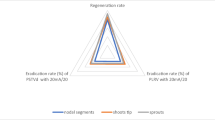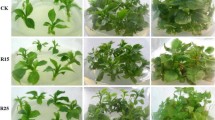Abstract
Potato (Solanum tuberosum L.) is the fourth most common food crop worldwide and one of the main food products in Kazakhstan. One of the factors leading to crop loss in potato is viral disease. There are more than 30 viruses known to cause diseases in potato. Therefore, using virus-free planting material is an important aspect of growing potato. It is relatively difficult to eliminate viruses from plants, despite the application of isolated apical meristems. In this study, we used the most effective methods to eliminate viral infections, such as electrotherapy, chemotherapy (40 and 50 mg/l), cryotherapy, and thermotherapy. Complete elimination of certain viral infections, such as PVM, PVS, PVX, and PVY, was achieved after chemotherapy with 40 mg/l of ribavirin. A multiplex RT-PCR method was used for efficient monitoring of viral infections, which is more precise than the enzyme-linked immunosorbent assay (DAS-ELISA). The obtained virus-free planting material will subsequently be used for industrial virus-free potato seed production in Kazakhstan.
Resumen
La papa (Solanum tuberosum L.) es el cuarto cultivo alimenticio mas común en el mundo y uno de los principales productos alimenticios en Kazakhstan. Uno de los factores que conducen a la pérdida del cultivo en papa es la enfermedad viral. Hay mas de 30 virus conocidos que causan enfermedad en papa. De aquí que, usando material de siembra libre de virus es un aspecto importante del cultivo de la papa. Es relativamente difícil eliminar virus de plantas, a pesar de la aplicación del aislamiento de meristemos apicales. En este estudio, usamos los métodos mas efectivos para eliminar las infecciones virales, tales como electroterapia, quimioterapia (40 y 50 mg/l), crioterapia y termoterapia. La eliminación completa de ciertas infecciones virales, tales como PVM, PVS, PVX y PVY, se logró después de quimioterapia con 40 mg/l de ribavirin. Se usó un método múltiple de RT-PCR para un monitoreo eficiente de infecciones virales, que es mas preciso que el inmuno-ensayo de enzimas conjugadas (DAS-ELISA). El material de siembra obtenido será subsecuentemente usado para producción industrial de semilla de papa libre de virus en Kazakhstan.




Similar content being viewed by others
References
Alam, M., M. Banu, A. Swaraz, S. Parvez, M. Hossain, M. Khalekuzzaman, and N. Ahsan. 2004. Production of virus free seeds using meristem culture in tomato plant under tropical conditions. Journal of Plant Biotechnology 6: 221–227.
Alam, I., S. Sharmin, M. Naher, M.J. Alam, M. Anisuzzaman, and M. Alam. 2010. Effect of growth regulators on meristem culture and plantlet establishment of sweet potato (Ipomoea batatas L.). Plant Omics 3: 35–39.
Alexandrova, A.M., O.V. Karpova, R.M. Nargilova, R.V. Kryldakov, A.S. Nizkorodova, A.V. Zhigaylov, E.M. Yekaterinskaya, S.V. Kushnarenko, R.Zh. Akbergenov, and B.K. Iskakov. 2018. Distribution (Solanum tuberosum) of potato viruses in Kazakhstan. International Journal of Biological Chemistry 11 (1): 33–40.
Ali, M.A., M. Nasiruddin, M.S. Haque, and S.M. Faisal. 2013. Virus elimination in potato through meristem culture followed by thermotherapy SAARC. Journal of Agriculture 11: 71–80.
Awan, A.R. 2007. In vitro elimination of potato leaf roll polerovirus from potato varieties. European Journal of Scientific Research 18 (1): 155–164.
Bădărău, C.L., F. Damşa, and N. Chiru. 2014. Effects of some electrotherapy treatments of PVX infected potato plantlets cv. Roclas, on several biological development indicators. In: J. Hort. Forest Biotechnology 18 (3): 25–29.
BIOREBA. 2018. http://www.bioreba.ch/
Brison, M., M.T. de Boucaud, A. Pierronnet, and F. Dosba. 1997. Effect of cryopreservation on the sanitary state of a cv. Prunus rootstock experimentally contaminated with plum pox potyvirus. Plant Science 123: 189–196.
Cassells, A.C. 1982. The elimination of potato viruses X, Y, S and M in meristem and explant cultures of potato in the presence of Virazole. Potato Research 25: 165–173.
Clark, M.F., and A.N. Adams. 1977. Characteristics of the micro plate method of enzyme-linked immunosorbant assay for the detection of plant viruses. The Journal of General Virology 34: 475–483.
Conrad, P.L. 1991. Potato virus S-free plants obtained using antiviral compounds and nodal segment culture of potato. American Potato Journal 68: 507–513.
Danci, O., L. Erdei, L. Vidacs, M. Danci, A. Baciu, I. David, and F. Berbentea. 2009. Influence of ribavirin on potato plants regeneration and virus eradication. Journal of Horticulture, Forestry and Biotechnology 13: 421–425.
Dedic, P. 1975. The effect of potato virus a (PVA) on yield in some potato varieties. Ochrana Rostlin 11: 127–133.
Duncan, D.B. 1955. Multiple range and multiple F tests. Biometrics 11: 1–42.
Emami, D., J. Meybodi, and N. Mozafari. 2011. Application of electrotherapy for the elimination of potato potyviruses. Journal of Agricultural Science and Technology 13: 921–927.
Espinoza, N.O., R. Estrada, D. Silva-Rodriguez, P. Tovar, R. Lizarraga, and J.H. Dodds. 1986. The potato: A model crop plant for tissue culture. Outline of Agriculture 15: 21–26.
Faccioli, G. 2001. Control of potato viruses using meristem and stem-cutting cultures, thermotherapy, and chemotherapy. In Virus and virus-like diseases of potatoes and seed potatoes, ed. G. Loebenstein, P.H. Berger, A.A. Brunt, and R.G. Lawson, 365–390. Dodrecht, The Netherlands: Kluwer Academic Publishers.
Faccioli, G., and M. Colalongo. 2002. Eradication of potato virus Y and potato leafroll virus by chemotherapy of infected potato stem cuttings. Phytopathologia Mediterranea 41 (1): 76–78.
Faccioli, G., C. Rubies-Autonell, and R. Resca. 1988. Potato leafroll virus distribution in potato meristem tips and production of virus-free plants. Potato Research 31: 511–520.
Faccioli, G., and R. Zoffoli. 1998. Fast eradication of potato virus X (PVX) and potato virus S (PVS) from virus-infected potato stem-cuttings by thermotherapy. Phytopathologia Mediterranea 37: 9–12.
Gianni, F. 2002. Eradication of potato virus Y and potato leafroll virus by chemotherapy of infected potato stem cuttings. Phytopathologia Mediterranea 41: 76–78.
Griffiths, H.M., and S.A. Slack. 1989. Effect chemical and heat therapy on virus concentrations in in vitro potato plantlets. Canadian Journal of Botany 68: 1515–1521.
Hamm, P.B., and D.C. Hane. 1999. Effects of seedborne potato leafroll virus on russet Norkotah potato. Plant Disease 83: 1122–1124.
Hane, D.C., and P.B. Hamm. 1999. Effects of seedborne potato virus Y infection in two potato cultivars expressing mild disease symptoms. Plant Disease 83: 43–45.
Hao, A.Y., J.J. Zhang, and J.P. Shen. 2007. Types of potato viruses and their control. Inner Mongolia Agricultural Science and Technology 2: 62–63.
Huang, P., Q. Yan, and G.Y. Din. 2009. Occurrence and control of potato virus S in Guizhou. Guizhou Agricultural Sciences 37: 88–89.
Huhnlein, A., N. Drechsler, P. Steinbach, T. Thieme, and J. Schubert. 2013. Comparison of three methods for the detection of potato virus Y in seed potato certification. Journal of Plant Diseases and Protection 120 (2): 57–69.
Jansky, S.H., L.P. Jin, K.Y. Xie, C.H. Xie, and D.M. Spooner. 2009. Potato production and breeding in China. Potato Research 52: 57–65.
Klein, R.E., and C.H. Livingston. 1982. Eradication of potato virus X from potato by ribavirin treatment of cultured potato shoot tips. American Potato Journal 59: 359–364.
Liu, W.P. 2007. Synergistic effect of potato virus Y (PVY) and potato spindle tuber viroid (PSTV) on tuber yield of potato. Journal of Heilongjiang August First Land Reclamation University 19: 40–43.
Loebenstein, G., and G. Thottappilly. 2003. Virus and virus-like diseases of major crops in developing countries. Netherlands: Springer.
Mahmoud, S.Y.M., M.H. Hosseny, and M.H. Abdel-Ghaffar. 2009. Evaluation of some therapies to eliminate potato Y potivirus from potato plants. International Journal of Virology 5 (2): 64–76.
Meybody, D., J. Mozafari, N. Babaeiyan, and H. Rahimian. 2011. Application of electrotherapy for the elimination of potato potyviruses. Journal of Agricultural Science and Technology 13: 921–927.
Murashige, T., and F. Skoog. 1962. A revised medium for rapid growth and bio-assays with tobacco tissue cultures. Physiologia Plantarum 15: 473–497.
Muthoni, J., H. Shimelis, and R. Melis. 2013. Alleviating potato seed tuber shortage in developing countries: Potential of true potato seeds. Australian Journal of Crop Science 7 (12): 1946–1954.
New Prospects for Potato Seed Production in Kazakhstan. 2017. https://agro-mart.kz/novyie-perspektivyi-semenovodstva-kartofelya-v-kazahstane, accessed January 21, 2017.
Nie, X., and R.P. Singh. 2001. A novel usage of random primers for multiplex RT-PCR detection of virus and viroid in aphids, leaves, and tubers. Journal of Virological Methods 91: 37–49.
Peiman, M., and C. Xie. 2006. Sensitive detection of potato viruses, PVX, PLRV and PVS, by RT-PCR in potato leaf and tuber. Australasian Plant Disease Notes 1: 41–46.
Reddy, B.J., R. Mandal, M. Chakroborty, L. Hijam, and P. Dutta. 2018. A review on potato (Solanum tuberosum L.) and its genetic diversity. Int J Gen 10 (2): 360–364.
Salazar, L.F. 2001. Virus diseases of potatoes. Enc Life Sci (pp. 1–8).
Sileks. 2020. http://www.sileks.com/ru/production.php?folder=172.
Singh, R.P., J. Kurz, and G. Boiteau. 1996. Detection of stylet-borne and circulative potato viruses in aphids by duplex reverse transcription polymerase chain reaction. Journal of Virological Methods 59: 189–196.
The Committee on Statistics Ministry of National Economics of the Republic of Kazakhstan. 2018. http://www.stat.gov.kz.
Verma, N., R. Ram, and A.A. Zaidi. 2005. In vitro production of Prunus necrotic ringspot virus-free begonias through chemo- and thermotherapy. Scientia Horticulturae 103: 239–247.
Wambugu, F.M., G.A. Secor, and N.C. Gudmestad. 1986. Eradication of potato virus Y and S from potato by chemotherapy of cultured axillary bud tips. American Potato Journal 62: 667–672.
Wang, X.W. 1999. Effect of infection status of potato virus Y and potato virus X on tuber yield of potato. An Rep, China’s Pot Assoc (pp. 285–289).
Wang, M., L. Chen, Z. Zhang, D.R. Blystad, and Q.C. Wang. 2018. Cryotherapy: A novel method for virus eradication in economically important plant species. Plant Cell Culture Protein Methods In Molecular Biology 1815: 257–268.
Wang, Q., W.J. Cuellar, M.L. Rajamäki, Y. Hirata, and J.P.T. Valkonen. 2008. Combined thermotherapy and cryotherapy for efficient virus eradication: Relation of virus distribution, subcellular changes, cell survival and viral RNA degradation in shoot tips. Molecular Plant Pathology 9: 237–250.
Wang, X.M., L.P. Jing, and H. Yi. 2005. Advances in breeding of potato virus-resistant cultivars. Chinese Potato Journal 19: 285–289.
Wang, R.G., and L.H. Liu. 2009. Reduction of tuber yield caused by co-infection of potato virus Y (PVY) and potato spindle tuber viroid (PSTV). Chin Pot J 9: 218–222.
Wang, Q., Y. Liu, Y. Xie, and M. You. 2006. Cryotherapy of potato shoot tips for efficient elimination of potato leafroll virus (PLRV) and potato virus Y. Potato Research 49: 119–129.
Waterworth, H.E. and A. Hadidi. 1998. Economic losses due to plant viruses. In: A. Hadidi, R.K. Khetarpal, H. Koganzawa (eds). Plant Vir Dis Cont. APS, St. Paul, MN. (pp. 1–13).
Whitworth, J.L., P. Nolte, C. McIntosh, and R. Davidson. 2006. Effect of potato virus Y on yield of three potato cultivars grown under different nitrogen levels. Plant Disease 90: 73–76.
Xie, J.H. 2007. Current status and perspectives of potato production in China. Journal of Agricultural Extension 23: 4–7.
Xie, K.Y., D.Y. Qu, L.P. Jin, and W.F. Pang. 2008. Potato production in China and its comparison with the world. World Journal of Agricultural Research 349: 35–41.
Xu, H.M., J.D. Aubin, and J.B. Nie. 2010. Genomic variability in potato virus M and the development of RT-PCR and RFLP procedures for the detection of this virus in seed potatoes. Virology Journal 25: 2–7.
Zapata, C., Jr. Miller, and B. Smith. 1995. An in vitro procedure to eradicate potato viruses X,Y, and S from Russet Norkotah and two of its strains. In Vitro Cellular & Developmental Biology: Plant 31: 153–159.
Zhang, W., Zh. Zhang, G. Fan, Y. Gao, J. Wen, Y. Bai, C. Qiu, Sh. Zhang, Y. Shen, and X. Meng. 2017. Development and application of a universal and simplified multiplex RT-PCR assay to detect five potato viruses. Journal of General Plant Pathology 83: 33–45.
Acknowledgments
The study was part of the project AP05131947: “Highly efficient production of potato virus-free planting material using a bioreactor”, funded by a grant from the Science Committee of the Ministry of Education and Science of the Republic of Kazakhstan.
Author information
Authors and Affiliations
Corresponding author
Ethics declarations
Conflict of Interests
The authors declare no conflict of interest.
Rights and permissions
About this article
Cite this article
Daurov, D., Daurova, A., Karimov, A. et al. Determining Effective Methods of Obtaining Virus-Free Potato for Cultivation in Kazakhstan. Am. J. Potato Res. 97, 367–375 (2020). https://doi.org/10.1007/s12230-020-09787-z
Published:
Issue Date:
DOI: https://doi.org/10.1007/s12230-020-09787-z




